Thoughts and reports on the NSW Champs, 20-21 September 2019

Yengo National Park is a large (150,000 hectare) tract of land in the north-eastern section of the world-heritage Greater Blue Mountains Area. It doesn’t get many visitors, much of it is declared wilderness, and it’s only 100km from the Sydney CBD.
It’s classic Sydney-sandstone country; flat on the top, cliffs on the sides, and broad valleys in between. Mount Yengo (660m) is the exceptional feature. Like the other basalt-topped peaks in the northern Wollemi, such as Coriaday and Corricudgy, it looms over the surrounding dissected plateau. It is perhaps more dramatic in that it stands alone, and it holds special meaning to indigenous people as the stepping off point for Baiame after he had created this landscape.

So why haven’t we run a rogaine there before?
In big part, because of the access; there’s 32km of narrow, dirt trail from The Great North Road to the Big Yango camping area. It’s OK for most road vehicles but it does require time and care. Despite the organiser’s warnings many competitors were surprised by, as Chris Stevenson cited, that “tedious dirt road.”
Gill Fowler organised delivery trucks to provide marquees and portaloos. At 8 o’clock Friday morning she had to meet them at Laguna, then escort them into the Hash House site. Organiser’s also had to tow the large catering trailer, and other heavy loads including a tonne of water. After the 3rd or 4th trip the road became familiar and less daunting, but it still took over an hour to drive those 32kms. There also lurked the unlikely risk of heavy rain which would have closed the road and forced a cancellation of the event.
Another reason we haven’t rogained in Yengo is to do with the history of the Park. The Big Yango property was only morphed into the National Park in 2000. Soon after, in 2009, two-thirds of the Park were designated as wilderness, thus becoming inaccessible to our sport.
Move to 2015, when Vivien de Remy de Courcelles created a NavShield event, mid-winter, based in the Big Yango frost hollow. This year, after our exploration of a site on the Southern Highlands was abandoned due to cliff-lines and landowner access, it was a simple solution for Vivien to re-use Yengo with it’s sole land manager. Unfortunately the Big Yango Hash House site was booked on the weekend for which the NSW Champs were scheduled, so we had to move to the following weekend. (This meant however that the flag-hanging team got to enjoy the full moon.)
THE COURSE
There was near unanimous agreement that the map was excellent, that the course layout made route planning a true puzzle, and that there were good options to return to the Hash House.
Gill Fowler was coordinator for the event and also explored much of the area while vetting and hanging flags. She “found the event area very special, rich in vegetation diversity and aboriginal heritage, something I don’t get to appreciate as greatly when competing at the pointy end of a rogaine. It’s also an area that has limited cars and no evidence of trail or mountain bike tracks, an added bonus.”
More from Gill, “I was excited that it was primarily feature navigation, little need for my compass, and some of the terrain was steep, but these were in short rather than long climbs. I found the area reasonably open, with some scrub, so I was surprised that some rogainers considered it very scrubby. (But then, perhaps I would too if out there for 24 hours.)”
The accessible hash house put pressure on the caterers, perhaps due to many 24-hour competitors returning about the same time as the 8-hour event finished.
NAVSHIELD 2015
Vivien recalls that the course for NavShield was very different to this year. In 2015 the same Hash House site was at the edge of the map and the course extended to the west. “At NavShield”, says Vivien, “we had controls in the wilderness area but did not go as far south-west, east or even north” as the recent Champs. “Traditionally NavShield has only about 40 controls, and we use the topographic map of the area to replicate what happens when emergency services are called for a search, as if grabbing a map off the shelf … and yes, we know that things are different now with online maps and GPS. Anyway the topo maps for Big Yango have 20m contours, do not show any cliffs, and are missing some very clear trails. I did add one trail for safety in 2015. Map reading was very different compared to the accurate map we had for the NSW Champs (e.g. if those 20m contours are very close there must be a cliff). When setting NavShield I tried to avoid trails, whilst I try to create routes using trails for the Champs.”
Many who did the 2015 event recall the cold weather. Tristan White commented that it was easy to rest and be lazy this year, whereas “one advantage of an event as bloody cold as the Navshield was that we never wanted to stop for long!”
David Williams and Ronnie Taib won in 2015 with 2400 points clearly ahead of the Sydney University Bushwalking team’s 2080 points. When using the word “win”, we should consider that standard Navshield teams are handicapped by their larger team and the obligation to carry camping and safety equipment. One wonders if this previous experience helped Ronnie and Dave this year.
THE MAP
Phil Whitten is a map freak who delights in preparing an accurate, navigational tool as well as an art piece. You can access the map here.

The map was unusual in having four callouts – sections from the map expanded to 1:5,000 scale – where Vivien had taped passes around or through clifflines. This meant three controls were squares rather than circles.
Julie Quinn was very positive of the map, saying “Phil did an awesome job. I love the new LIDAR dataset with the contours that are so accurate. He also performed some magic with the algorithm getting all of the cliff lines and watercourses on the map. We did get confused near 47 where the track on the ground crossing the gully didn’t really exist. That’s what you get sometimes in the dark.”
Chris Stevenson concurred. “I loved the map, a superb piece of cartography. One change perhaps – the hatching of the OOB areas obscured the contours.”
Tristan White would have liked the map to show the thicker vegetation. Gill Fowler appreciated the addition of the cliffs in the map.
Let’s give Ronnie Taib the final say. “It was my sort of map, much more to my taste than the WRC map. I don’t recall we spotted any error, and the marked cliffs were usually useful. Well done, Phil!”
THE COMPETITION
Congratulations to David Williams and Ronnie Taib, the 2019 NSW Rogaining Champions. Dave & Ronnie are showing strong consistency, defending their title win at Abercrombie last year (and in 2017 they were only 10 points below the winners at Mt Werong.)
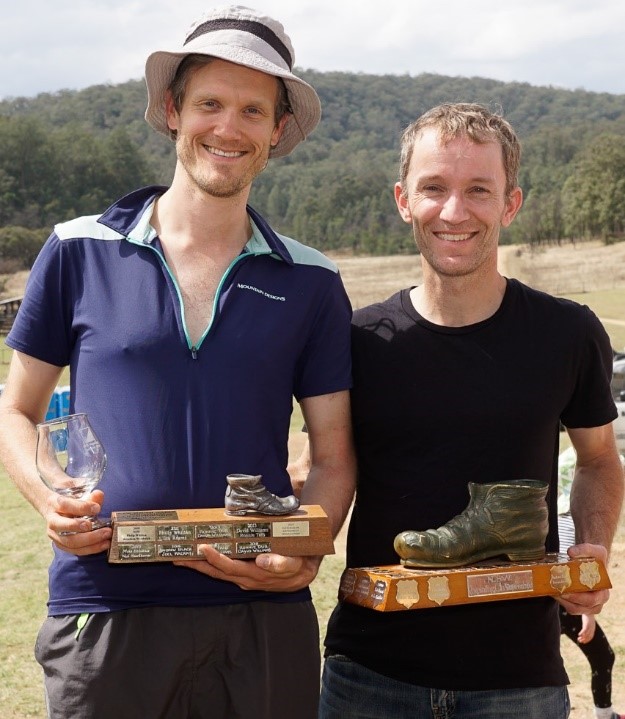
Julie Quinn and David Baldwin were a mere 20 points behind. One presumes both teams have done their post-event analysis to consider how they might have changed the final result.
Full results are available on the event website. This year’s top ten are:
- David Williams & Ronnie Taib .. 3,060 points
- Julie Quinn & David Baldwin .. 3,040
- Jackson Bursill & Thomas Banks .. 2,740
- Mathew Collin & Ivan Koudashev .. 2,480
- John & Mardi Barnes .. 2,450
- Fergus Macleod & Max Messenger .. 2,440
- Tristan White & Aurelian Penneman .. 2,410
- Andrew Renwick & Peter Marshman .. 1,850
- Glenn Disalvia, Ryan Puklowski & Ginaya Dunn .. 1,820
- Graham Field & Martin Dearnley .. 1,690
In the associated 8-hour event, elite veterans Mike Hotchkis and Glenn Horrocks scored 1,450 points, 200 ahead of Andrew & Nicole Haigh.
HOW GOOD ARE THE TOP TEAMS?
Here’s a graph showing progress of the top two teams. Ronnie referred to the low patch they had, due to dehydration, which shows as that flat section about 10-11pm. But by 10am Sunday both teams had the same score, 2770 points, and finished at the same, strong rate. Perhaps Julie and David benefited from their brief visit to the Hash House about 7:45pm; they certainly were more consistent during the night.

CREDITS
- Coordination & Liaison: Gill Fowler
- Course Setting & Flag Hanging: Vivien & Justine de Remy De Courcelles, Emmanuelle Convert
- Map: Phil Whitten
- Vetting & Flag Hanging: Gill Fowler, Phil Whitten, Belinda & Andrew Pope, Tom Brennan, Rachel Grindlay, Richard Patterson, Mel Thomas
- Administration: Anita Bickle
- Catering: The Pope family (Andrew, Belinda, Sean & Nick), Trevor Gollan
- General Help: Amanda Mackie, Graeme McLeod, Ann Newman, Michael Watts, Clinton Bradley, Bert van Netten, Phil Whitten, Pawel Wagner, Monica Wong, Peter Watterson, Sam Hussein, Lisa x
- Photography: Bruce Sutton
- Safety: Lesley Clarke with SES-Bush Search and Rescue
- Flag Collection: John & Mardi Barnes, Phil Harding, Sandra Thomas, Pam, Bob & Ann Montgomery
- Catering Trailer: Andrew & Belinda Pope; Admin Trailer: Trevor Gollan
- Landowners: NSW National Parks & Wildlife Service, Simone Smith & the Laguna Community (for water supply)
- Website: Chris Stevenson
- Equipment: Mark von Huben
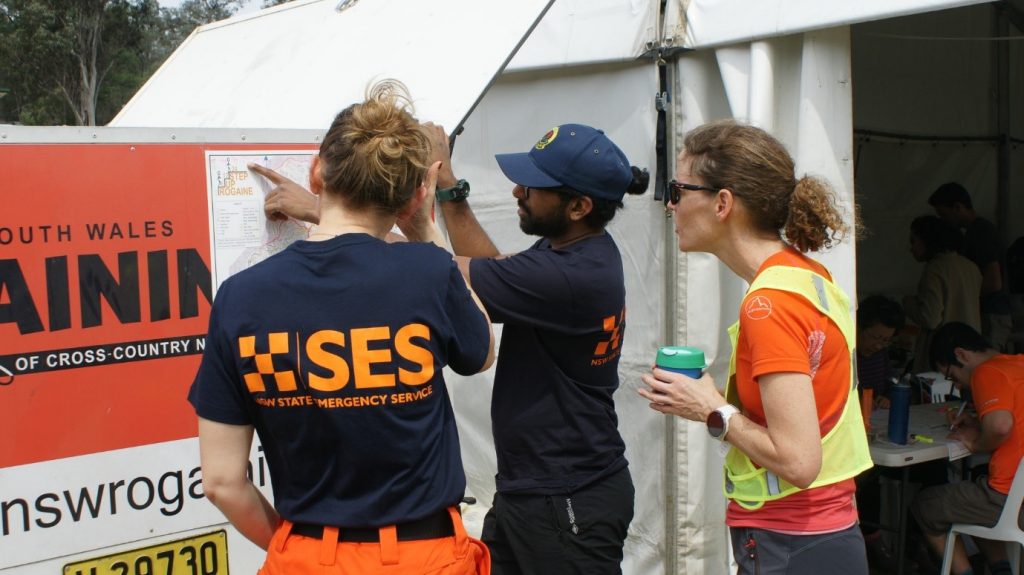
QUOTES
- I’d have happily cried but couldn’t waste any water (Ronnie Taib)
- It was really fantastic to see the big number of novice 24-hour teams (Gill Fowler)
- We’re not as quick these days – but we’re still optimistic of our capabilities! (John Biddiscombe)
- I hoped to learn enough about Hash House Food Prep to be more help in the future – but – came away intimidated and with deeper respect for what the Pope’s pulled off (Phil Witten)
- I’d give the Rogaine a 10/10. There wasn’t one disappointment with the experience (Allan Bourke)
- Setting navigation courses, similarly to leading walks for my bushwalking club SBW, is a way to show others some nice areas that you might not find easily (Vivien de Remy de Courcelles)
I asked a bunch of people for their Observations and Cogitations
David Baldwin and Julie Quinn are the top Mixed team in Australia, as evidenced at the recent World Champs in Spain where they won the Mixed Veterans category and were 2nd in the Open Mixed. They also placed 2nd Outright at the last Australasian Champs, at Manumbar in S-E Queensland.

Julie writes… Many thanks to the NSWRA for putting on a super event for the NSW Champs. I would describe it as a true bush rogaine, with very little of our time spent on tracks or in open country. Couldn’t be much more of a contrast to the World Rogaine Champs at La Molina, which was open high country and pine forest with trails everywhere.
I had to look up where Yengo NP was, and after putting a pin on the map I was pretty excited to explore the country. The only downside was the distance from Canberra. A huge thanks to Toni and Smiffy who put us up on Friday evening and then again, after the event, welcomed us back to their house for a sleep and feed on our way home.
Yengo has a real feel of history with the various Aboriginal artefacts around the place. I spent quite a bit of time pondering where and how the people lived in this country, although it must have been quite different without the European farming influence and the few animals. We missed seeing the stencils near 47 although we did look around a bit in the dark for them.
We decided fairly quickly that climbing up and down over the ridges was pretty slow, especially through the lines of rock. However, the open valleys had the cobblers pegs/farmers friend (Bidens pilosa) weed which was so awful when you stumbled into a clump of it, it had David cursing. Some of the other gullies where they were a bit more rainforest-like were a joy on Saturday afternoon. Just a bit cooler and damp providing some relief from the much-warmer-than-Canberra temperatures.
The positioning of the water drops provided us with a challenge to carry enough water and we were pretty thirsty when we came through the Hash House about 7:30 pm. But we had been warned and it was obvious that there was a constraint of access around the course.
Definitely a great event, and an area that NSW should use again one day. It’s a pity the surrounding area is wilderness as I am sure there is so much more to explore.
Thanks Julie & David for making the trek from Canberra and bringing your classy competition.
Chris Stevenson and John Clancy scored 870 points placing them 6th overall in the 8-hour competition. Chris (below, at left) is our Webmaster and a regular commentator on NSW rogaining activities.
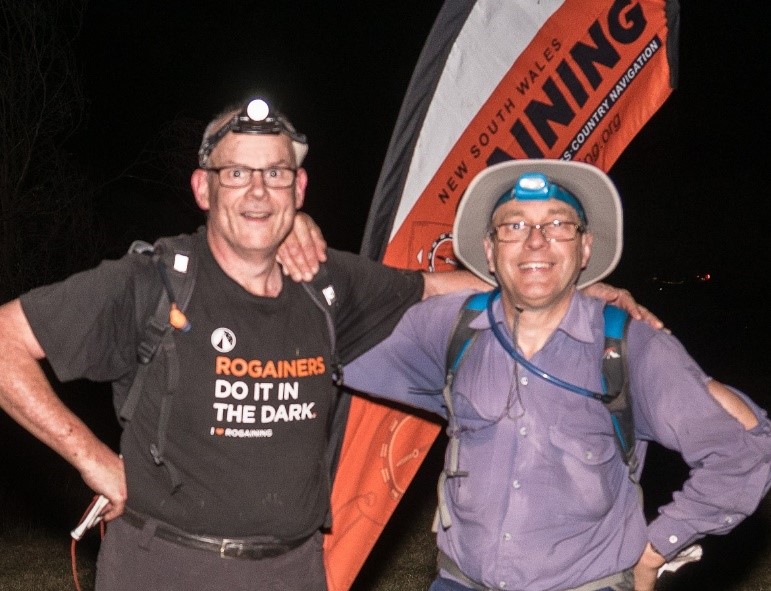
Asked to summarise his experience, Chris wrote… it was a good event in a difficult location. I was aware of the area but missed the NavShield and had also planned to mountain bike ride from Putty Road to Laguna, not done yet due to logistical complexities.
Highlights? I enjoyed the country. It is unusual to have the long open valleys that are not fight-scrub. (This will change over time with the cows having been removed.) We saw a red bellied black snake, managed some brilliant night navigation, lots of kangaroos or wallabies (they weren’t wearing signs), and some grinding marks which are uninteresting.
It was just great to explore somewhere new.
Lowlights? The flies, heat and dirt road were tedious, and I would have preferred to do the 24-hour.
What can we do to improve? Why not also run a four hour event so it would be 4/8/24. This would probably help the event pay for itself. I suspect that the 4-hour event would be well attended, despite the drive, and it would be a marginal cost and effort for NSW Rogaining.
Brett Davis (below, at right) and Mike Ward won the Men’s Ultravet category with 1,350 points. Brett was 2nd in his class at Abercrombie 2018, and writes of this year’s event… I thought pretty much everything about the event was excellent – location, organisation, map, food, admin.
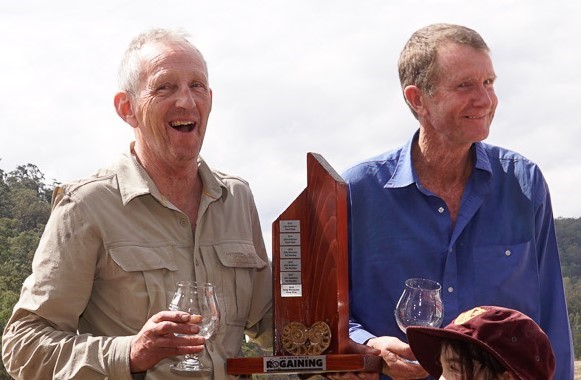
I hadn’t been to Yengo before. Given the good weather we experienced leading up to the event, and despite the reasonably heavy rain a week before, the road into the HH was in pretty good condition (for a national park track.) It was quite a long way to the HH from the bitumen on a dirt road that might have deteriorated rapidly if it had rained. But it was ideal rogaining country – plenty of hills but not too high, a bit of thickish scrub but generally pretty open, the creeks were dry and easily followed most of the time, and the clifflines were negotiable in the main.
The map felt flimsy when I first picked it up, but I had no problems with it at all and my initial feeling was misplaced.”
Did you keep going for the full 24 hours? We tried, but Mike had basically insisted on two loops with a short stop at the HH for food and water in between. There are two obvious gaps in our splits. The first occurred when both Mike and I ran out of water at the north of the course just on dusk. We picked up one control in the dark, and tried for another, but gave up the search very early on to walk about 4k back to the HH for a meal and water. The break was reasonably leisurely, and then we walked a few kilometres south to get to some higher value controls – so the gap stretched to about 3½ hours.
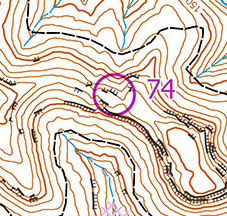
The second big gap in our splits happened when we didn’t find 74. I’m still kicking myself over that one! The description was “rock platform” and I had a middle-of-the-night mindset that a rock platform was either a large, flat section of open rock on top of the ridge, or a raised rock platform also on top of the ridge. And we found the latter, but alas – no flag. If I had been thinking straight, and had actually looked at the map a little more closely, I would have seen the cliffline clearly marked in the centre of the circle and reasoned that a rock platform might actually be the edge of the cliff, but as it was around 3am I was a little bit brain-dead. After abandoning the search, our next target was back along the ridge we had just walked and then further north – quite a distance. The scrub on this ridge turned out to be reasonably thick too, so the going was slow – and Mike doesn’t like the “off track” stuff very much. We picked up our next control just before dawn after another gap of 3½ hours.
Highlights and lowlights? The weather was a highlight, almost perfect. It was a bit too warm during both days, but the night was beautiful, with virtually no breeze and mild enough to get by in a cotton shirt without the need for gloves, beanies, or thermals. The lowlight was missing 74!
What animals or unusual features did you encounter? We encountered kangaroos, wallabies and one lone wombat, but the birds were amazing! The calls of White-throated Gerygones were a constant around the HH, and there were plenty of calls from Rufous Whistlers, Golden Whistlers, Grey Shrike-thrushes, Eastern Yellow Robins and Wonga Pigeons on the course. My highlight was flushing a pair of White-throated Nightjars on an open ridge very close to 83. As you can probably tell, I’m a birdwatcher.
On the “other” rock platform near 74 – which was a solid, raised block of rock, we found lots of grinding grooves near a couple of rock holes filled with water.
Any suggestions? My only gripe, and it is reasonably minor, was with the locations of the water drops – they just didn’t seem to be really user-friendly. And I’m not complaining because I ran out of water, as that was my fault. I had two litres in pockets on the side of my backpack, and thought I had packed another 700ml inside – but hadn’t. Stupid error!
Tristan White is highly visible in NSW Rogaining due to his role as publicity officer, most notably as the editor of our newsletters, and for his energy. He is also very active as a competitor, organiser and mountain biker.
Tristan and Aurelian Penneman placed 7th overall at Yengo, after coming 2nd at this years Paddy Pallin 6-hour. Tristan also took 2nd place last year at the NSW Champs, teamed with Mike Hotchkis. Here’s some extended comments about his Yengo experience.
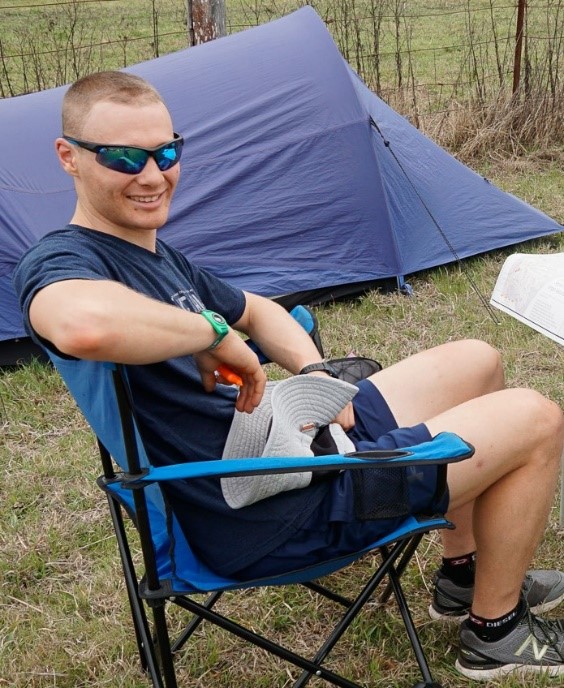
It wasn’t our easiest event. A few hours in it was clear that we were not going to go home with a trophy. I could feel something of a headache and a stomach that didn’t feel great. Not sure if it was me having too much/little to eat or drink, still recovering from a nasty chest infection (that I exacerbated doing the ACT cyclegaine two weeks before) or just having an off day. I just didn’t have the energy and adrenaline that I usually do, even in 24-hour events. We stopped a LOT during the night, and would have to motivate each other to start moving again.
Consequentially, we decided to pull in a couple of hours early so Aurelien could get back home to his young daughter. It was to emerge that, had we gotten a mere 80 more points, our position would have been bumped up from 7th to 4th. At the time I had no problem spending a couple of extra hours resting but looking back on it I do regret doing an event that I haven’t squeezed in every possible CP! Doing a rogaine, particularly a 24-hour, relies on being there mentally, and I wasn’t.
The Course? I wish to compliment the organisation team for getting the HH in the centre of the course. Although we didn’t go back to it I know a lot of teams did, and with some better planning we certainly could have and lightened our load.
However, in terms of terrain, in all honesty, it wouldn’t have been my top pick for a course area. I found many of the watercourses really nice and open and they were some of my favourite sections, but many of the ridges were very slow and unpleasant. Although I knew it was the same location as the 2015 Navshield (which is traditionally thick and scrubby) I had read in the course notes that the scrub was minimal so I wore a T-shirt, no gaiters … and I suffered. The hills were also a lot more brutal than I imagined. Although the actual elevation difference was much less than the infamously hilly Abercrombie, the combination of their steepness, the number of loose rocks, cliffs to dodge and all the prickly crap just made it much slower than we expected.
I think I’d have been better prepared for the course if we’d understood how thick and slow the bush was. I’d have also worn long sleeves and gaiters in favour of long pants had I known. As the wisdom goes you only appreciate the difficulty when you’ve seen it first hand!
The map was excellent for the most part. I didn’t find any occasions that CPs were in the wrong place, or contour detail was wrong, and was amazed about the accuracy of the clifflines, something that is so subjective, but aside from 95 it seemed they were exactly where I expected them.
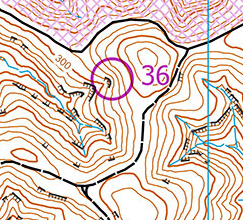
Highlights and Lowlights? The blunders at 36 and 95 were the obvious downturns; the first and final CPs attempted in the dark. We wasted almost an hour at 36 after shooting slightly above the CP, at which point the watercourse was almost indistinguishable. We went back to the track to have another crack at it, and still missed it. Looking at the GPS history later on it’s clear we were not far at all from the CP. But the vagueness of the feature, the adjustment to the dark, and the dense bush meant that it was harder than it otherwise would have been.
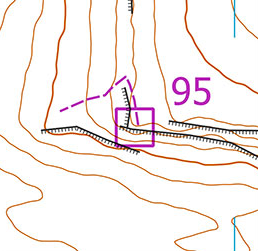
95 was a long slog. I don’t want to say how long we spent looking for it as it’d be humiliating. Basically we found what we thought was the cliffline to the east of the control and followed it to the corner, and there was no flag. We then made our way back along a different cliff, to find yet another corner, again no flag. After countless to’s and fro’s and consultations, we were about to give up when I looked behind to see a flash of white and orange. Needless to say the GPS-tracker looked positively embarrassing, but in all fairness there must have been some unmarked cliffs. It would have been around 4am, of course when we’re at the biggest risk of making goof-ups.
Did you laugh or cry? There was some laughter before and after the event, perhaps even a little during the event. There were no actual tears (yes, I have cried in other events) but I won’t share a transcript of the things I said when I couldn’t find CP 95!
Animals or unusual features? The main unusual feature was the number of other rogainers we saw over the course of the night. Last NSW Champs Mike and I saw three other teams between 3pm and 11am (including three sightings of our rivals David and Ronnie as we could see them obviously getting the leading edge over us!). This time, we must have seen several dozen, which doesn’t happen often in a 24-hour.
Ideas for improvement? The organisation was excellent. I think the kiddygaine was great and I’m glad to see the efforts were reflected in the turnout.
I do think that prickly areas such as many that were on this course are simply painful and don’t add much value to the sport. I find it really stunts my motivation to keep fighting my way through the night. My ideal rogaining country is what’s found west of the Blue Mountains or in the Southern Highlands – enough bush to shelter from the heat, wind or cold but not much low prickly crap.
Consider having a short novice/kids’ course before future events, incl. urban events – perhaps at a 1:2,500 scale with a few CPs near the HH, which doubles up as a sample of what CPs look like. Then kids that don’t do the main event can have a crack at it as well.
Belinda and Andrew Pope, with their teenage sons Sean & Nick volunteered to run the Hash House, a task that involves menu planning, shopping, transporting the basic foodstuffs, prepping, serving and cleaning up. They also spent the previous weekend hanging flags.
Andrew reported that… the overall experience was rather hectic and stressful. It was our first time running the hash house but, yes, we probably would do it again.
Highlights? I guess it was getting everyone fed and pulling it off. We flexed as required with the cooking and received positive feedback on the food.
I liked being told by a team that they could smell the food km’s away from the hash house.
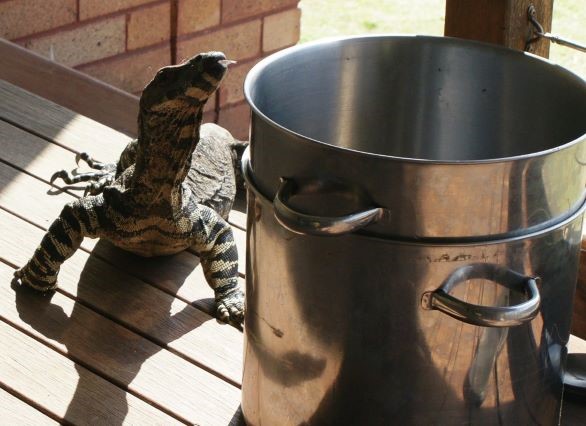
The four goannas in, or hovering outside, the hash house were a pleasant amusement, distraction and concern. We had to be wary of them underfoot, not wanting to hurt them, and vice versa.
The par-boiled sausages from Tender Value meats were great (factor in around 1.2/participant.) Shepherds Bakery cakes were good… though a bit expensive, and Harris Farm in Pennant Hills were fantastic.
Maybe we have some sponsorship opportunities there. How about that great cauliflower soup?
The recipe for the soup was from the Web. Here’s the ingredients (just multiply by 40-50):
1 onion diced
3 garlic cloves (minced)
½ tsp dried sage
½ tsp paprika
½ tsp turmeric
2 average sweet potatoes (peeled and chopped)
1 average cauliflower (chopped into florets)
4 cups low sodium vegetable broth
13.5 oz (400ml) light coconut milk
salt & pepper (to taste)
Challenges? We needed more helpers at times, especially when we were preparing and serving dinner on Saturday night. We needed more pots (8 to 10) and/or a better way of keeping prepared food warm whilst more is cooked, and we’d prefer pans with heavy bases to avoid burning food so easily – that was frustrating.
Next time? We’d simplify the dinner menu (delete one meat dish), order less bacon (about half, 11 kgs, would have been right, and we’d skip the yoghurt. The soup and veggie stew quantity were excessive, and obviously we’d get less bread. We should have labelled the dishes and whether they contain gluten, dairy, etc.
Other improvements? I’d question the 8 hour + 24 hour, unless you have a big group to cater for that evening rush, and enough pots to keep the food coming along. 15 in 24 hour may have worked better.
I’d prefer 10L water containers, rather than 20-25L’s for volunteers to use round the kitchen. The big containers are too heavy to lift. We used our own.
Stirring the big pots gets dangerous due to the height. You need a way of bringing that down so an average height person can safely stir a pot. Smaller pots, different burners etc.
And finally, keep the catering trailer clean. We spent a while cleaning it up on Saturday morning.
How was your flag-hanging weekend? We loved our wander around the course, with the beautiful open creeks. The hills weren’t too big, the scrub was bearable, and we saw wombats, goannas, red-tailed black cockatoos and lots of kangaroos.
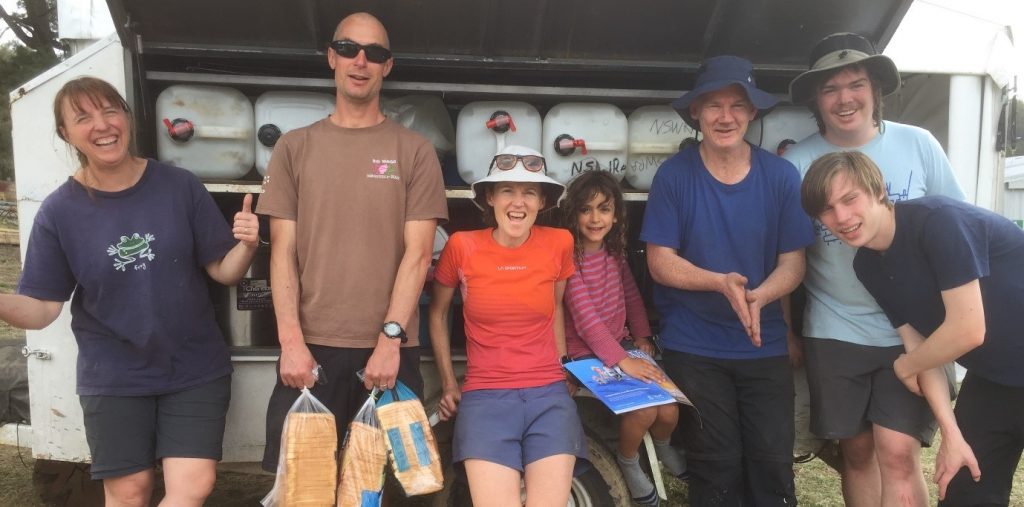
John Biddiscombe and his regular teammate, John Bishop, have a different approach to a 24-hour rogaine. This year they scored 260 points, 20 more than 2018 where they came last, and this year was quite different in that they collected more points but incurred a 250 penalty for being late to the Finish – and they didn’t come last.
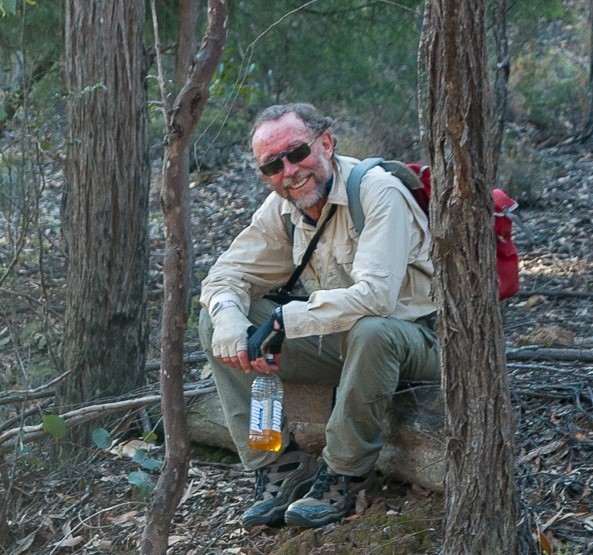
Let John tell the story… I thought that Yengo was a very honest rogaine. After getting to the general area of each control, the setters were considerate on their placing of the targets.
As for John and I, we usually bite off more that we can chew. I’m probably the fitter in the team, Bish has lost a bit of fitness over the years which is to be expected – not as quick these days – but we’re still optimistic of our capabilities!
We always like to get out to the nice country away from the madding crowds. This inevitably gets us far away from the Hash House and often creates long marches along fire trails at the end of the event. On this occasion, we failed to heed the advice of the course setter and decided that we wouldn’t let a bit of scrub stop us coming down the ridge south of W1. Big mistake. It was awful and progress was very slow. Night fell and after a couple of hours thrashing about trying to make southerly progress, we decided to have a kip until dawn when we could fix our position on the ridge, which we did.
We are always prepared for a forced benighting as it has happened on previous rogaines. We don’t worry too much and are both reasonably comfortable and experienced in the bush.
Mel de Laat and Allan Bourke travelled from Brisbane to get some training prior to the Australasian Champs in Tasmania next month. In response to my query about having a southern holiday they responded, “No, just a long weekend.” Well they got that practice, collecting 1,540 points, placing 12th overall and 3rd in the Mixed Veterans category.
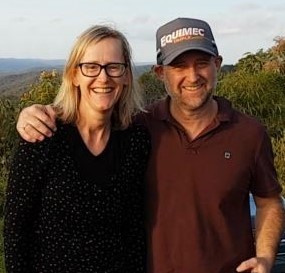
Here’s some thoughts from Mel… We thoroughly enjoyed the Yengo Rogaine. The location was beautiful, and the organisation was very smooth. It was my first 24-hour rogaine, and this was one of the reasons we made the effort to come down from Brisbane. We are heading to Tassie next month, and wanted to get some practice at a longer event having missed the Qld champs. We were happy with our rogaine, but did get some sleep in order to drive home safely. Maybe one day we will go all night!
The cliffs were challenging from an ‘up and down’ perspective, but never put us too far off course so were an interesting added feature. We saw roos, goannas, black cockatoos, a red bellied black snake and a small skink/lizard thing with a tail like a beaver in the middle of the night. The map was great, a good level of detail to help with setting bearings.
Overall, thanks for a great event. The hard work by the organisers was very evident.
And from Allan… There wasn’t one disappointment with the experience, and that’s saying something as I hate hills. The cliff faces were quite overwhelming at first glance but, like the course notes said, there was usually a way through.
The surroundings at Yengo NP were quite stunning, and it was simply the best rogaining country we have stepped foot on.
We found the people extremely friendly and welcoming, from the moment we met you up at the lookout to the time we left and chatted with a few other participants.
Whilst we appreciate next year may be a different course, our advice would be not to change anything else.
Jackson Bursill and Thomas Banks finished 3rd overall with 2,740 points
Jackson writes… The map and the course were great. I really enjoyed all the rock climbing and cliff scaling. It was my first time to Yengo NP and my first proper rogaine in over a year – good to get the cobwebs out as well. I particularly enjoyed exploring all the caves on the course and seeing the indigenous rock art and other artefacts. We executed our route mostly as planned but had to cut out many of the controls in the south-west corner which means we didn’t get to see the mountain up close. It was a great rogaine and a big thanks to all the course setters, vetters and organisers.
Now to hear from the winning team, Ronnie Taib and Dave Williams. Ronnie (below, at left) writes… It was a tough event. On first analysis we thought it was not as brutal in terms of climbs as some other past events. However, the terrain, heat and restricted water made it physically hard, making us sick and on the brink of giving up.

From the NavShield I remembered very beautiful green creek banks, followed by the most devilish scrub I’ve been through and extreme cold at night.
I’m happy to have been back, as this course was mostly open, with some awesome watercourses planted with majestic grey gums. We didn’t find the sort of breathtaking lookouts that the Blue Mountains may offer, but nice views on quiet valleys and on the ancient Yengo. I can totally understand Aboriginals seeing it as a significant location.
Highlights and Lowlights? We got strongly dehydrated, feeling rather sick and unable to eat, hence getting really low on energy. We had to stop twice for more than 30 minutes at water drops, taking a big toll on our morale, but it seems to have been a necessary evil as we became stronger again later.
The main highlight was walking cross country for most of a rogaine, with very little tracks or roads. As said above, some watercourses were memorable.
How can we improve? Rent a helicopter to drop water in more places. Apart from that nothing much. It looked like the course was friendly to people doing 8-hours only. The central Hash House is a great privilege if you intend to come back for food or sleep.
Did you laugh or cry? I’d have happily cried but couldn’t waste any water. The taped tracks were a bit comical as we didn’t seem to follow any until the end – to the flag.
It was very amusing that everyone pretended we had beaten Julie and David. Now that it’s all over, tell us frankly how far behind we really were 🙂
OK, they actually beat you by 230 points, but we penalised them 250 because they’re from Canberra.
Finally, here is Vivien de Remy de Courcelles’ perspective. As course setter for NavShield 2015 and this year’s Champs we can assume that few people know the area as well as he.
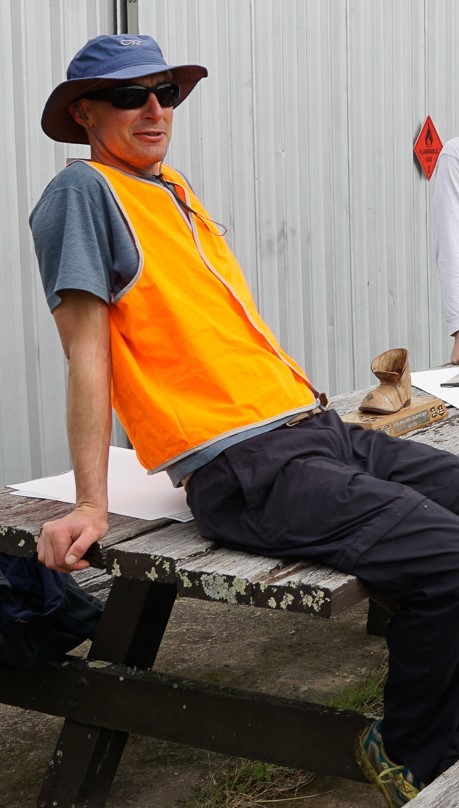
Tell us why you wanted this job? I volunteered to set the Champs after a conversation with Gill who told me there was no one to do it, and whilst she was happy to, it would mean that she would not enter a 24-hour rogaine in 2019. I could not possibly let this be … but then Gill took on the organiser’s role … and therefore did not enter the rogaine!
How much time setting the course? I spent only 8 days setting and Emmanuelle and Justine spent 6 days. It feels like not a lot of time because of our knowledge of the area after setting NavShield there in 2015.
We also spent a weekend hanging flags although we did less than others. I’d like to point out that unlike our previous experience hanging flags for the NSW Champs, it was the most social hanging weekend we have had thanks to a crew of 12 people, including ourselves, hanging flags all on the same weekend and camping together on Saturday. I encourage course setters and organisers to organise such a hanging weekend and rogainers to volunteer to hang flags. I will add that flag hanging and vetting is a great way to do the rogaine without the pressure of the clock and therefore is very suited to a family outing. Since Justine was born we have helped with vetting, hanging and retrieving flags at five rogaines and always enjoyed it.
Are you addicted to course-setting? We were asked to set NavShield for the first time in 2014. BWRS (now SES BSAR) needed a course setter and we were wondering what to do with our weekends looking at getting in the bush but mindful that it was more difficult with a 1-year-old in tow or rather in a backpack. Then once you have done one, you feel you need to do it another time to do it better. And why not trying a third time for your best shot. The fourth time it was more a case of “no one else wants to do it” and the fifth time, the original course setter had to attend to a family member early in the process. And then this year I had that conversation with Gill. So not quite a drug although considering I am setting the first event of Sydney Summer Series this year (again) and it is scheduled for 9 October, you might disagree.
I will add that setting navigation courses, similarly to leading walks for my bushwalking club SBW, is a way to show others some nice areas that you might not find easily.
What about the Kiddygaine? Phil and Gill had the idea of the kiddygaine. It was great fun to watch the kids running on the course and I loved that they all did the 8-hour event the day before or delayed their second loop of the 24-hour event or came back early to do the kiddygaine – two events in one weekend, these kids are tough.
Did you climb Big Yango? No, during my first visit to the area I read the info sign that asks not to climb Mt Yengo for cultural reasons. I was also told there is no point in doing so as there are no views at the top.
Highlights? I loved finding Aboriginal sharpening grooves and hand stencils. It was the first time I saw hand stencils apart from well known and usually protected sites. I also loved exploring deeper into some of the creek systems; the cliff lines and massive trees upstream were superb.
Feedback I received was positive. It’s hard to plan a course. I tend to divide my courses and give the same point value to each part.
It was great to have such a good team during the event. I particularly enjoyed our meal time with everyone around the table. There is always a great spirit at rogaines but it was particularly nice to be able to share the moment with all the volunteer helpers.
Any complaints? Scrub yes, although it was from someone who mentioned it in 2015 already and may have won both events! Being a fellow Frenchman I know that we have delicate skin! I think his idea of scrub and mine are quite different … his example was of a creek bed covered with bracken, which does not qualify as scrub in my book, although I did agree with him that this particular section of creek was slow going. He joked that he would call DOCS on us after I told him that Justine did walk that creek bed. Anyway he keeps coming back so he must like it! Besides having soft skin, we French people must be a bit masochistic, or it is a drug as you suggested.
One last thing: I was wondering if those who mentioned dehydration did carry 3L of water as advised in the final instructions. If not perhaps we should work on a way to make some critical info more visible or send a reminder on Facebook: when hanging flags I went through 2L of water in about 6 hours on both days. I did not drink that much on either of my previous visits.
Thankyou Vivien for your efforts, leadership and positivity.
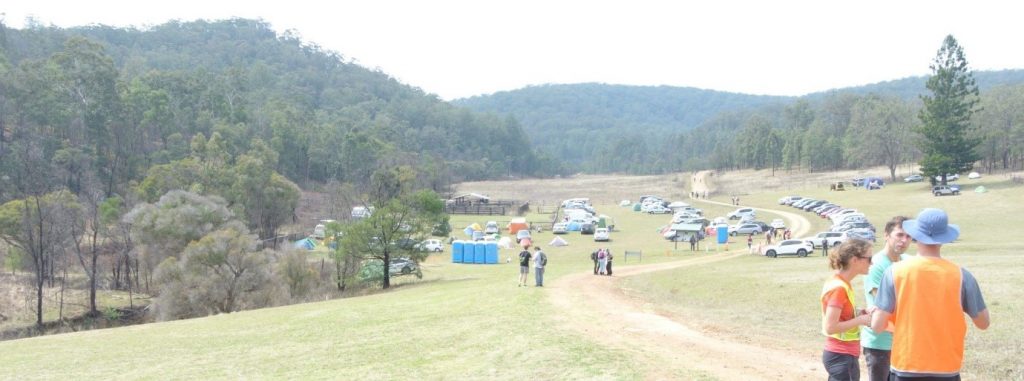
Trev,
Thanks for this, it’s a good read. It was interesting to read about the water drops. It’s a problem with no easy solution. I carried 3 litres (I always do) but I had consumed almost all of this by 5pm. Fortunately our course took in W2 at about that time but there were fewer water drops on the east of the course and I can see that the top teams would have struggled. Perhaps it would be good policy to make the water drops controls so teams are incented to visit them. However I suspect that this would not have changed the situation for this event.